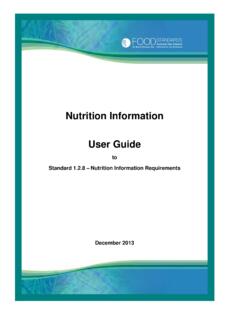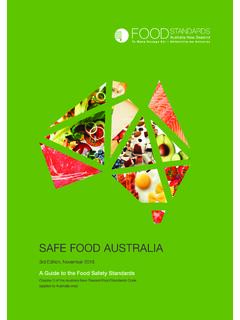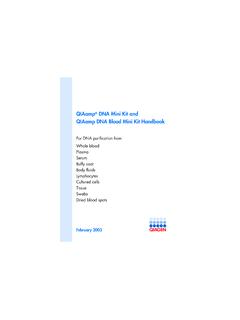Transcription of Bacillus cereus - Food Standards
1 Bacillus cereus Bacillus cereus is a spore forming bacterium that produces toxins that cause vomiting or diarrhoea. Symptoms are generally mild and short-lived (up to 24 hours). B. cereus is commonly found in the environment ( soil) as well as a variety of foods. Spores are able to survive harsh environments including normal cooking temperatures. Description of the organism B. cereus is a Gram-positive, motile (flagellated), spore-forming, rod shaped bacterium that belongs to the Bacillus genus. Species within this genus include B. anthracis, B. cereus , B. mycoides, B. thuringiensis, B. pseudomycoides and B. weihenstephanensis (Rajkowski and Bennett 2003; Montville and Matthews 2005). Genomic sequencing data has shown B. anthracis, B. cereus and B. thuringiensis to be very closely related (Rasko et al. 2004). with their 16S rRNA gene sequence sharing more than 99% similarity (Ash et al. 1991). B. cereus is widespread in nature and readily found in soil, where it adopts a saprophytic life cycle; germinating, growing and sporulating in this environment (Vilain et al.)
2 2006). Spores are more resistant to environmental stress than vegetative cells due to their metabolic dormancy and tough physical nature (Jenson and Moir 2003). B. cereus produces two types of toxins emetic (vomiting) and diarrhoeal causing two types of illness. The emetic syndrome is caused by emetic toxin produced by the bacteria during the growth phase in the food. The diarrhoeal syndrome is caused by diarrhoeal toxins produced during growth of the bacteria in the small intestine (Ehling-Schulz et al. 2006). Growth and survival characteristics Strains of B. cereus vary widely in their growth and survival characteristics (refer to Table 1). Isolates from food and humans can be subdivided as either mesophilic or psychrotrophic strains. Mesophilic strains grow well at 37 C but do not grow below 10 C; psychrotrophic strains grow well at refrigeration temperatures but grow poorly at 37 C (Wijnands et al. 2006a). All isolates of B. cereus associated with emetic toxin production have been found to be mesophilic in nature (Pielaat et al.
3 2005; Wijnands et al. 2006b). The maximum salt concentration tolerated by B. cereus for growth is reported to be (Rajkowski and Bennett 2003). B. cereus growth is optimal in the presence of oxygen, but can occur under anaerobic conditions. B. cereus cells grown under aerobic conditions are less resistant to heat and acid than B. cereus cells grown anaerobically or microaerobically (Mols et al. 2009). Mesophilic strains of B. cereus have been shown to have greater acid resistance than psychrotrophic strains (Wijnands et al. 2006b). The observed average decimal reduction value or D-value (the time required to reduce the initial concentration of bacterial cells or spores by 1 log10 unit) was min for mesophilic strain stationary phase cells (pH , 37 C). In comparison the D-value for psychrotrophic strains under the same conditions was min (Wijnands et al. 2009; Augustin 2011). There is considerable strain variability in the heat resistance of B. cereus spores. The D-values of some strains is up to 15 to 20 times greater than the more heat sensitive strains.
4 The D-value at 85 C is 106 min in phosphate buffer, and at 95 C is min and 1. min in distilled water and milk, respectively (ICMSF 1996). Heat resistance is increased in high fat and oily foods, for example in soybean oil the D-value at 121 C is 30 min. Spores are more resistant to dry heat than moist heat, with heat resistance usually greater in foods with lower water activity. Spores are also more resistant to radiation than vegetative cells (Jenson and Moir 2003). Nisin is a preservative that is used to inhibit the germination and outgrowth of spores. Antimicrobials which inhibit the growth of B. cereus include benzoate, sorbates and ethylenediaminetetraacetic acid (Jenson and Moir 2003). Table 1: Limits for growth of B. cereus and toxin production when other conditions are near optimum (Kramer and Gilbert 1989; Sutherland and Limond 1993; ICMSF 1996; Fermanian et al. 1997; Finlay et al. 2000). Bacterial Growth Emetic Toxin Diarrhoeal Toxin Production Production Optimum Range Optimum Range Optimum Range Temperature 30 40 4 55 12 15 12 37 32 10 43.
5 ( C). pH - - 10. Water - - - - - activity Symptoms of disease B. cereus causes two types of foodborne illness emetic (vomiting) and diarrhoeal syndromes. The emetic syndrome is an intoxication that is caused by ingestion of a cyclic peptide toxin called cereulide that is pre-formed in the food during growth by B. cereus . This syndrome has a short incubation period and recovery time. The symptoms of nausea, vomiting and abdominal cramping occur within 1 5 hours of ingestion, with recovery usually within 6 24 hours (Schoeni and Wong 2005; Senesi and Ghelardi 2010). The diarrhoeal syndrome is caused by enterotoxins produced by B. cereus inside the host. The incubation period before onset of disease is 8 16 hours and the illness usually lasts for 12 14 hours, although it can continue for several days. Symptoms are usually mild with abdominal cramps, watery diarrhoea and nausea (Granum 2007). In a small number of cases both types of toxin are produced, and emetic and diarrhoeal symptoms occur (Montville and Matthews 2005).
6 Neither form of illness is considered life- threatening to normal healthy individuals, with few fatal cases reported (Jenson and Moir 2003). B. cereus has been associated with non-food related illness, although this occurs rarely. The bacterium has been found in postsurgical and traumatic wounds and can cause opportunistic infections, especially in immunocompromised individuals, such as septicaemia, meningitis and pneumonia. B. cereus has also been known to occasionally cause localised eye infections in humans (Schoeni and Wong 2005). 2. Virulence and infectivity The pathogenic mechanism for the B. cereus emetic illness has been well characterised. The emetic toxin (cereulide) causes vacuole formation in HEp-2 cells in the laboratory (Agata et al. 1994; Schoeni and Wong 2005). Using an animal model, Agata et al. (1995). showed that cereulide causes vomiting, potentially by binding to the 5-HT3 receptors in the stomach/small intestine to stimulate the vagus nerve and brain.
7 Cereulide is produced by a non-ribosomal peptide synthetase (NRPS) complex (Horwood et al. 2004; Toh et al. 2004). The entire NRPS cluster has been characterised (Ehling-Schulz et al. 2006) resulting in a highly specific method for detection of cereulide producing B. cereus strains (Fricker et al. 2007). Production of the emetic toxin has been shown to occur in skim milk within the temperature range of 12 37 C, with more toxin produced at 12 and 15 C compared to higher temperatures (Finlay et al. 2000). The emetic toxin is highly resistant to environmental factors, showing stability from pH 2 11 and during heating to 100 C for 150 minutes (pH ) (Jenson and Moir 2003; ESR 2010). Three types of enterotoxins are associated with the diarrhoeal form of disease. These are: the three component enterotoxin haemolysin BL (HBL), the three component non-haemolytic enterotoxin (NHE) and the single component enterotoxin cytotoxin K. After consumption of food containing B. cereus , the enterotoxins are released into the small intestine during vegetative growth following spore germination, and by any surviving vegetative cells (Wijnands et al.)
8 2009). The diarrhoeal enterotoxins can be produced in the temperature range of 10 43 C, with an optimum of 32 C (Kramer and Gilbert 1989; Fermanian et al. 1997). Production occurs between pH 10, with an optimum of pH 8 (Sutherland and Limond 1993). The diarrhoeal enterotoxins are stable at pH 4 11 and inactivated by heating to 56 C for 5 minutes (Jenson and Moir 2003). Maltodextrin is known to stimulate growth of B. cereus and to aid diarrheal enterotoxin production in reconstituted and stored infant milk formulae (Rowan and Anderson 1997). It has also been shown that B. cereus produces more HBL and NHE under conditions of oxygen tension (low oxygen reduction potential) that simulate the anaerobic, highly reducing fermentative conditions encountered in the small intestine (Zigha et al. 2006). Up to 26% of B. cereus vegetative cells can survive conditions that simulate passage through the stomach. The survival rate of the vegetative cells is dependent on the strain type, phase of vegetative cell growth and the gastric pH (Wijnands et al.
9 2009). As diarrhoeal enterotoxins are unstable at low pH and are degraded by digestive enzymes, any enterotoxins pre-formed in food would be destroyed during passage through the stomach and so not cause illness if ingested (Jenson and Moir 2003). In contrast, spores of B. cereus are able to pass unaffected through the gastric barrier. The spores contain receptors that need triggering by certain low molecular weight substances to commence germination. These inducers may be present in the food as well as the intestinal epithelial cells. In the small intestine the spores germinate, grow and produce enterotoxins (Wijnands 2008). A crucial virulence factor required for causing the diarrhoeal symptoms is the ability of the vegetative cells and spores of B. cereus to adhere to the epithelial cell wall of the small intestine. The adhesion efficiency of spores and cells has been shown to be low, approximately 1% (Wijnands 2008). 3. The ability of the enterotoxins to act as tissue-destructive proteins and damage the plasma membrane of the epithelial cells of the small intestine suggests a role for these enterotoxins in causing diarrhoea (Senesi and Ghelardi 2010).
10 Beecher et al. (1995) showed HBL causes fluid accumulation in ligated rabbit ileal loops, implicating a role in diarrhoea. However, direct involvement of NHE and cytotoxin K in causing diarrhoea is yet to be demonstrated (Senesi and Ghelardi 2010). Efficient horizontal DNA transfer systems are present within the B. cereus group, enabling plasmids to be transferred among strains of different species of this group (B. cereus , B. anthracis and B. thuringiensis). The plasmids are known to be important determinants of virulence properties of B. cereus strains, since they contain genes responsible for virulence such as the ces gene cluster required for cereulide formation and emetic disease (Arnesen et al. 2008). Furthermore, chromosomal DNA contains genes associated with the diarrhoeal disease, and is therefore present in all strains. In view of the homogeneity of the B. cereus group, an online tool has been developed for ascertaining the foodborne virulence potential of strains (Guinebreti re et al.)










